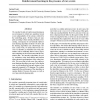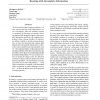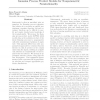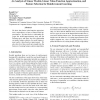ICML
2008
IEEE
16 years 1 months ago
2008
IEEE
Rich representations in reinforcement learning have been studied for the purpose of enabling generalization and making learning feasible in large state spaces. We introduce Object...
120
Voted
ICML
2008
IEEE
16 years 1 months ago
2008
IEEE
A good distance measure for time series needs to properly incorporate the temporal structure, and should be applicable to sequences with unequal lengths. In this paper, we propose...
126
Voted
ICML
2008
IEEE
16 years 1 months ago
2008
IEEE
This paper is concerned with the generalization ability of learning to rank algorithms for information retrieval (IR). We point out that the key for addressing the learning proble...
90
Voted
ICML
2008
IEEE
16 years 1 months ago
2008
IEEE
We consider the task of reinforcement learning in an environment in which rare significant events occur independently of the actions selected by the controlling agent. If these ev...
ICML
2008
IEEE
16 years 1 months ago
2008
IEEE
In real-world machine learning problems, it is very common that part of the input feature vector is incomplete: either not available, missing, or corrupted. In this paper, we pres...
120
click to vote
ICML
2008
IEEE
16 years 1 months ago
2008
IEEE
Stationarity is often an unrealistic prior assumption for Gaussian process regression. One solution is to predefine an explicit nonstationary covariance function, but such covaria...
111
Voted
ICML
2008
IEEE
16 years 1 months ago
2008
IEEE
In inductive logic programming, subsumption is a widely used coverage test. Unfortunately, testing -subsumption is NP-complete, which represents a crucial efficiency bottleneck fo...
75
Voted
ICML
2008
IEEE
16 years 1 months ago
2008
IEEE
We show that linear value-function approximation is equivalent to a form of linear model approximation. We then derive a relationship between the model-approximation error and the...
118
click to vote
ICML
2008
IEEE
16 years 1 months ago
2008
IEEE
Learning to rank is becoming an increasingly popular research area in machine learning. The ranking problem aims to induce an ordering or preference relations among a set of insta...
117
click to vote
ICML
2008
IEEE
16 years 1 months ago
2008
IEEE
We show how the regularizer of Transductive Support Vector Machines (TSVM) can be trained by stochastic gradient descent for linear models and multi-layer architectures. The resul...




